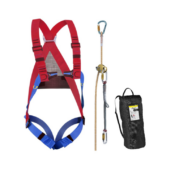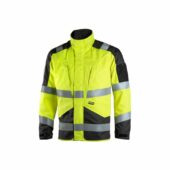Deciding between work overalls and coveralls can be challenging, especially when comfort and protection are at stake.
This guide will not only help you understand the differences but also ensure you choose the best option for your specific needs, backed by practical advice and expert recommendations.
As a bonus, we’ll also address the next steps to fully equip your workwear wardrobe, so you’re prepared for any task. For a deeper dive into selecting the best workwear, visit our Selecting The Best Work Overalls: A Practical Guide.
Understanding the Basics: Overalls vs. Coveralls
At first glance, work overalls and coveralls might seem similar, but their designs serve distinct purposes. Overalls consist of trousers with a bib-and-brace system, leaving the arms and upper body free.
This design prioritizes flexibility and ventilation. On the other hand, coveralls, also called boiler suits, provide full-body coverage, protecting both the upper and lower body.
This makes them ideal for tasks requiring sufficient protection against dirt, chemicals, or other challenges.
Key Features Comparison
| Feature | Work Overalls | Coveralls |
| Coverage | Lower body + partial upper body | Full-body coverage |
| Best For | Flexible, less challenging tasks | High-protection tasks |
| Ventilation | Excellent ventilation | Limited ventilation |
| Layering | Easy to layer with jackets or shirts | Often worn alone or with minimal layering |
| Common Uses | Construction, gardening, carpentry | Oil rigs, chemical handling, industrial cleaning |
Advantages of Work Overalls
Work overalls are known for their versatility and comfort, particularly in roles that demand movement and flexibility. With their bib-and-brace design, overalls offer freedom for the arms and shoulders, which is perfect for tasks like carpentry or machinery operation.
Additionally, they provide great ventilation, making them a better option for warm climates or physically demanding jobs.
When paired with other protective gear like work jackets or safety shoes, overalls can create a customized solution for varied work environments. Read our guide on Work Jackets: Selecting The Right Outerwear to find the best match.
Benefits of Coveralls

For jobs that involve complex or demanding environments, coveralls are indispensable. They provide complete protection from head to toe, providing protection from spills, splashes, and debris.
Industries like chemical processing, oil drilling, and industrial cleaning often require full-body coverage, making coveralls the go-to option.
Their single-piece design minimizes exposure to contaminants, providing robust protection compared to overalls. Additionally, coveralls offer optimal performance in cooler environments or tasks that prioritize safety and reliability.
However, coveralls are less breathable, so they’re better suited for cooler environments or tasks requiring high safety standards.
Choosing the Right Option for Your Job
The choice between overalls and coveralls depends on the nature of your work. Consider these factors:
- Work Environment: For tasks involving chemicals or challenging substances, choose coveralls. Overalls work well in less challenging, more mobile roles.
- Climate: Overalls offer better ventilation, making them ideal for warmer settings. Coveralls provide warmth and protection in colder environments.
- Layering Needs: Overalls allow for additional layers, while coveralls are typically worn as a standalone garment.
- Ease of Use: Overalls are easier to put on and take off compared to coveralls, which may be bulkier.
Safety Standards and Certifications
To ensure the highest level of protection, always verify that your overalls or coveralls meet recognized European safety standards. For instance:
- EN 343: Specifies requirements for protective clothing against rain and inclement weather.
- EN ISO 11612: Defines standards for garments that provide protection against heat and flames.
- EN ISO 13982-1: Pertains to chemical protective clothing, particularly for dust particles.
These certifications provide peace of mind and ensure your workwear is tailored to meet specific safety needs. To ensure confidence in your gear, check product labels or consult manufacturers for compliance details. Learn more about EN Standards from this guide in Wikipedia.
Practical Applications and Use Cases
Work Overalls in Action
Work overalls are favored by professionals like mechanics, carpenters, and warehouse workers. Their open design keeps you cool while protecting your clothes from wear and tear. If you need more information on specific applications, explore How to Choose the Right Overalls for Warehousing.
Coveralls in High-Protection Settings
Coveralls excel in specialized environments like oil rigs, chemical plants, and construction sites. They provide unmatched protection, supporting your safety in complex tasks. Learn more about coverall-specific uses in our article, How to Choose the Right Overalls for Construction.
Enhancing Protection with Accessories
Regardless of your choice, pairing overalls or coveralls with the right gear is crucial. Consider these:
- Safety Shoes: Protect your feet with durable, slip-resistant options. Refer to our guide, Choosing The Right Safety Shoes – A Buyer’s Guide.
- Work Pants: Layer under overalls for added comfort. Read How To Choose The Right Work Pants – A Buyer’s Guide.
- Work Jackets: Stay warm and dry with the right outerwear.
Final Thoughts
We hope this guide has clarified the key differences and benefits of work overalls and coveralls, empowering you to make an informed choice for your specific work environment.
Whether you need the versatility of overalls or the full-body protection of coveralls, we’ve got you covered with a wide range of options.
Explore our Work Overalls category for trusted brands and styles that suit your needs. Don’t forget to enhance your workwear with complementary gear like safety shoes and work jackets for maximum safety and comfort.
Have further questions? Reach out to us for tailored advice—we’re here to ensure you’re equipped for success in any task.
Frequently Asked Questions
Yes, both overalls and coveralls can be used for casual tasks. Overalls are great for tasks requiring flexibility, such as painting or gardening, while coveralls are ideal for messy DIY projects where full-body protection is needed.
Maintenance depends on the material and usage. For most overalls, regular washing with standard detergents is sufficient. Coveralls used in specialized environments, such as chemical handling, may require specific cleaning processes or even professional laundering to maintain their protective properties.
Yes, insulated overalls and coveralls are available. These are designed to provide warmth in cold conditions while maintaining the required protection level for your work environment.
Absolutely! Many overalls and coveralls come in high-visibility colors and feature reflective strips, meeting safety standards for environments where visibility is critical.
Proper fit is essential for comfort and safety. Overalls should fit snugly without restricting movement, while coveralls should allow for freedom of motion but not be overly loose to avoid snagging or exposure. Refer to the manufacturer’s sizing chart and consider layering needs when selecting your size.

















